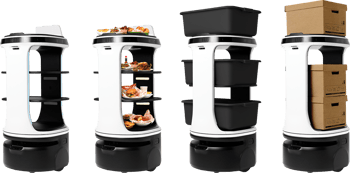Building and managing your restaurant team is a delicate balance. Every week’s staffing needs can be different and not having the right positions filled sets up a shift for disaster. Restaurants experience high staff turnover rates at 75%. Enacting solid scheduling and hiring practices will help keep your staff happy while providing them a path for growth. Here’s what you need to know to make that happen.
What positions to hire
As an independent restaurant owner or operator, you can’t do it all on your own. Here are the key positions you should hire for:
Managers
Managers are your go-to staffers for running the restaurant. These are seasoned hospitality professionals with 2-3 years of experience. The should be comfortable not only leading but dealing with conflict. Since burnout is common with restaurant managers, having a general manager and designated shift managers will help even out the load.
Responsibilities: Closing and opening shifts, tracking inventory, supply purchasing, training staff, enforcing restaurant best practices, supporting staff’s needs during a shift.
Chefs & Cooks
Depending on the size and style of your restaurant, you’ll want to think about hiring a head chef and a support staff of sous chefs to staff each shift. Head chef’s should have 2-3 year solid kitchen experience and the ability to manage fellow cooks effectively. Sous chefs or cooks don’t need to have as much experience, but most definitely an eagerness to learn. All should demonstrate the ability to have grace under pressure.
Responsibilities: Prepare food for service, execute and expedite food during a shift, prepare family meals.
Servers & Bartenders
These are your front of house soldiers who handle most interactions with your guest. They should be able to juggle multiple tasks while keeping a calm, welcoming demeanor. In the case of a bartender, they will need to have a base of beverage knowledge and know their way around a bar.
Responsibilities: Pre-shift prep work, taking and entering orders, talking with guests, pouring/making drinks, delivering food, handling guest payments.
Busers & Barbacks
These are entry-level, but no less crucial in your restaurant. In fact, 9 in 10 restaurant managers start in entry-level positions, so these are great slots to fill with new potential talent. Bussers and bar backs should be eager to learn and quick on their feet. You’ll want at least one of each per shift.
Responsibilities: Bussing glassware and food, restocking bartender and server stations, filling water glasses.
Dishwashers
Dishwashers are the unsung heroes of your restaurant. Plan on having at least one per shift. They should have good attention to detail but also be able to work quickly.
Responsibilities: Wash dishes, glassware, cutlery, etc., run any restaurant washing and drying equipment.
Hosts
Whoever you hire as your host will most likely be the first person your restaurant guest sees when they walk in in the door. They should be friendly and cool under pressure.
Responsibilities: Greeting guests, answering phones, taking and managing reservations, managing restaurant wait times, escorting guests to their table.
Where to hire
With over 600,000 restaurants operating in the U.S., hiring quality staff has never been more competitive. To snatch up the best talent there is out there, use these hiring streams:
Hospitality-specific job sites like Poached or Culinary Agents that actively recruit restaurant professionals.
Your website and social channels. These owned digital platforms already have a built-in audience that loves your restaurant.
Local culinary schools and groups are constantly bringing in fresh talent and industry veterans. Their job boards or networking events are worth checking out.
Word of mouth. This industry is fluid. When in doubt, reach out to your hospitality network and let them know you are looking. Incentives your staff by giving them a bonus for bringing on a strong new hire.
Staff training 101
Once you have hired your new staff, you want to get them on-boarded efficiently to get them on the floor ASAP. Make sure you include the following training steps so they feel comfortable in their responsibilities:
Orientation
This is a time to give an overview of your restaurant, it’s mission, best practices and menu. It’s also a good time for a general walkthrough, intros and filling out any paperwork.
Pro Tip: Create an employee manual so that new hires can take notes as you review restaurant policies and always have a reference to go back to
Demo
Train by demonstrating. This could be showing a barista how to pull an espresso or a dishwasher how to use a glass cleaner. The key is that these are hands-on learning sessions that take place outside of busy shifts so that new hires can see and then practice new skills.
Pro Tip: Schedule demo training before a shadow shift so they can see what they have learned in action.
Shadowing
A shadow shift allows a new hire to work alongside a seasoned staffer. The trainee can take over parts of service with confidence because they have a guide with them. Pro Tip: Find time at the end of a shadow to let your new hire sit with you and sample food or beverages on the house so they can learn about the menu more.
How to schedule restaurant staff shifts
Only about 44% of restaurant employees work in the industry full-time, which means over half your staff is likely juggling other jobs. Figuring out weekly shifts can feel like you’re trying to finish a neverending jigsaw puzzle. Here are some tips to help make scheduling easier on both you and your staff:
Set clear expectations as to what the job requires and how often they will be scheduled Get your schedule out ASAP. The sooner you get a schedule out, the sooner it becomes a priority to your staff. Getting schedules out 3-4 weeks in advance allows staff to plan ahead.
Have clear policies for requesting time off or shift changes. Outline cut off times and a set approval process for these requests.
Schedule in time for opening and closing prep work, otherwise, your staff may be flying out the door when their shift is done but there is still work to be done!
Staff scheduling software
One tool that can make scheduling a lot easier is staff scheduling software. These apps and management programs can help you organize shifts and enhance staff communication. Here are some things to look for when you are assessing these tech platforms:
User friendly. Your staff scheduling application should allow you to plug and play information and update it intuitively. It should also be easy for your staff to navigate, otherwise, they won’t use it.
Mobile-friendly. This is a must! Most people are on the go and use their phone to keep in touch. The software you pick must be optimized for mobile viewing for effortless viewing.
Communications capabilities. This software will be the hub for all your scheduling. It should provide notifications and messaging capabilities so that you aren’t doing double work.
POS integration. There is a reason that 76% of restaurants want their labor management tools to integrate with their POS. Integration allows you to correlate staff with shift sales to optimize your service and profits.
Built for restaurants. Any tech that is built specifically for restaurants is going to give you a leg up because it means the program was tailor-made for your line of work.
Staff management tips
Once you’ve got your staff and scheduling in place, the best way to minimize turnover is by investing in your team. Here are a few tactics that will make a difference in the long run:
Schedule regular check-ins and evaluations. Regular performance meetings help track growth and give staff an opportunity to give you feedback as well.
Offer ongoing education. Have open training for food, beverage and kitchen skills. Offer to pay for ongoing certifications to show your investment in your team.
Don’t forget about the holidays. November and December are high-volume times for restaurants. Set the expectations you have for your staff 3-4 months ahead of time. Take time off requests early to plan ahead.
Connect with your employees. Try not to make it all business. Ask them about their lives outside of work. Organize staff appreciation activities. Show that you care and you staff will put that same attitude back into their work.
[Photo: Michael Browning via Unsplash]





